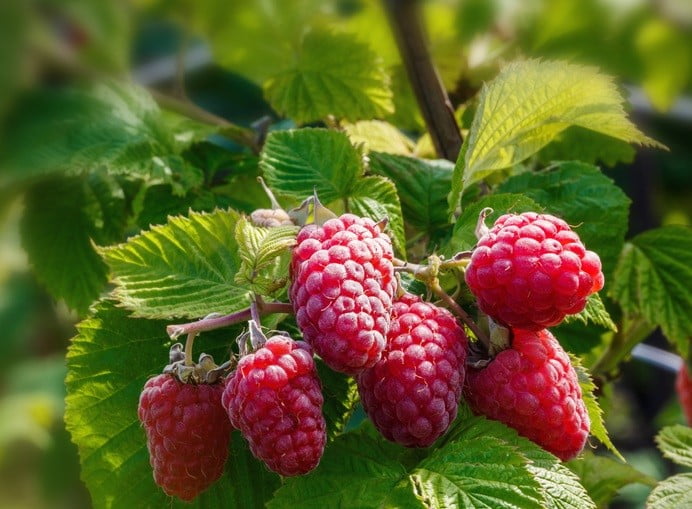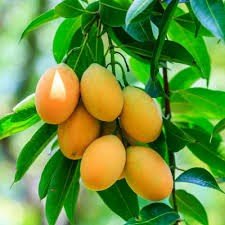Raspberry red
Is most often the source of a dietary supplement sold in many health food stores called ellagic acid. This substance found naturally in raspberries belongs to the family of phytonutrients called tannins, and it is viewed as being responsible for a good portion of the antioxidant activity of this (and other) berries.
As an antioxidant food containing ellagic acid, raspberries help prevent unwanted damage to cell membranes and other structures in the body by neutralizing free radicals. Ellagic acid is not the only well-researched phytonutrient component of raspberry, however. Raspberry’s flavonoid content is also well documented. Here the key substances are quercetin, kaempferol, and the cyanidin-based molecules called cyanidin-3-glucosylrutinoside and cyanidin-3-rutinoside. These flavonoid molecules are also classified as anthocyanins, and they belong to the group of substances that give raspberries their rich red color. Raspberries’ anthocyanins also give these delectable berries unique antioxidant properties, as well as some antimicrobial ones, including the ability to prevent overgrowth of certain bacteria and fungi in the body (for example, the yeast Candida albicans, which is a frequent culprit in vaginal infections and can be a contributing cause in irritable bowel syndrome).
Additionally, research is suggesting that raspberries may have cancer protective properties. Research with animals has suggested that raspberries have the potential to inhibit cancer cell proliferation and tumor formation in various parts of the body, including the colon.
Raspberries possess almost 50% higher antioxidant activity than strawberries, three times that of kiwis, and ten times the antioxidant activity of tomatoes, shows research conducted in the Netherlands and published in the journal BioFactors.
The biggest contribution to raspberries’ antioxidant capacity is their ellagitannins, a family of compounds almost exclusive to the raspberry, which are reported to have anti-cancer activity. Vitamin C contributes about 20% of the total antioxidant capacity, accounting for up to 30 milligrams in 100 grams (3.5 ounces) of fruit. Raspberries anthocyanins, especially cyanidin and pelagonidin glycosides, make up another 25%. And more good news: freezing and storing raspberries does not significantly affect their antioxidant activity, although in this study, their concentration of vitamin C was halved by the freezing process.
In addition to their unique phytonutrient content, raspberries are filled with traditional nutrients, primarily in the antioxidant and B vitamin categories. Raspberries emerged from our nutrient ranking system as an excellent source of HYPERLINK “http://www.whfoods.com/genpage.php?tname=nutrient&dbid=77” manganese and HYPERLINK “http://www.whfoods.com/genpage.php?tname=nutrient&dbid=109” vitamin C, two critical antioxidant nutrients that help protect the body’s tissue from oxygen-related damage. They also qualified as a good source of folate, magnesium, potassium and copper. Coupled with this, raspberries qualified as “excellent” in terms of HYPERLINK “http://www.whfoods.com/genpage.php?tname=nutrient&dbid=59” dietary fiber. This combination of nutrients makes raspberries a great fruit choice for having minimal impact on blood sugars.
Research published in Cancer Letters provides one reason why diets high in fruit help prevent cancer: raspberries, blackberries and muscadine grapes inhibit metalloproteinase enzymes. Although essential for the development and remodeling of tissues, if produced in abnormally high amounts, these enzymes play a significant role in cancer development by providing a mechanism for its invasion and spread.
Your mother may have told you carrots would keep your eyes bright as a child, but as an adult, it looks like fruit is even more important for keeping your sight. Data reported in a study published in the Archives of Ophthalmology indicates that eating 3 or more servings of fruit per day may lower your risk of age-related macular degeneration (ARMD), the primary cause of vision loss in older adults, by 36%, compared to persons who consume less than 1.5 servings of fruit daily.
In this study, which involved over 110,000 women and men, researchers evaluated the effect of study participants’ consumption of fruits; vegetables; the antioxidant vitamins A, C, and E; and carotenoids on the development of early ARMD or neovascular ARMD, a more severe form of the illness associated with vision loss. While, surprisingly, intakes of vegetables, antioxidant vitamins and carotenoids were not strongly related to incidence of either form of ARMD, fruit intake was definitely protective against the severe form of this vision-destroying disease. Three servings of fruit may sound like a lot to eat each day, but raspberries can help you reach this goal. Top your morning cereal or lunch time yogurt or cottage cheese with fresh raspberries. Transform the taste and presentation of any green salad with a handful of raspberries and a splash of balsamic vinegar.
Raspberries are an excellent source of fiber, manganese and vitamin C. . They are a very good source of vitamin K and a good source of magnesium, folate, omega-3 fatty acids, copper, vitamin E and potassium. In addition, they contain significant amounts of the anti-cancer phytochemical ellagic acid.*











Reviews (0)
There are no reviews yet.